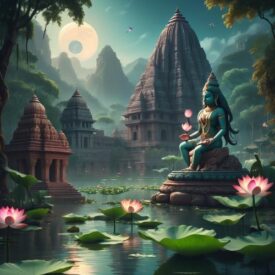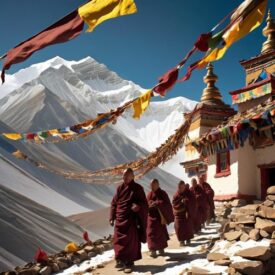South Asian Mythology
South Asian mythology boasts a vibrant tapestry, woven from the ancient traditions of India, Tibet, Nepal, and Bhutan. These interconnected narratives capture the essence of human experience, exploring themes of creation, destruction, love, loss, and the eternal struggle between good and evil.
At the heart of Indian mythology lies the rich collection of Vedic texts, hymns praising the power of nature and the divine. These early tales introduce us to the celestial pantheon, with powerful deities like Indra, the king of gods, and Agni, the god of fire. Grand epics like the Ramayana and Mahabharata capture the imagination with their tales of heroic deeds, epic battles, and divine intervention. The Ramayana, a story of love, duty, and exile, follows Rama, the prince of Ayodhya, as he rescues his wife Sita from the clutches of the demon king Ravana. The Mahabharata, a sprawling tale of war and kinship, depicts the conflict between the Pandavas and the Kauravas, two branches of a royal family.
High in the Himalayas, Tibetan mythology flourishes with a unique blend of Buddhist teachings and ancient animistic beliefs. Here, the focus shifts towards spiritual enlightenment. The concept of reincarnation and the cyclical nature of existence takes center stage. The powerful beings are often associated with specific locations. Yidams, wrathful deities, are seen as protectors, while peaceful Buddhas represent the path to enlightenment. The Dalai Lama, the spiritual leader of Tibetan Buddhism, is believed to be the reincarnation of Avalokitesvara, the Bodhisattva of compassion.
Despite geographical separation, Indian and Tibetan mythologies share remarkable similarities. Both revere Mount Kailash, a sacred peak believed to be the abode of Shiva in Hinduism and the embodiment of Mount Meru in Tibetan Buddhism. Deities like Indra and Saraswati, the goddess of knowledge and music, find counterparts in Tibetan traditions. The concept of Dharma, the righteous path, underscores both mythologies, emphasizing the importance of living a moral life.
South Asian mythology extends far beyond the celestial realm. A rich bestiary of fantastical creatures populates these tales. The mighty Garuda, a half-man, half-eagle, serves as Vishnu’s loyal mount in Hinduism. The cunning Naga, serpent-like beings with human heads, possess immense power and knowledge. Tibetan mythology features the fearsome Yeti, a bipedal creature said to roam the snowy mountains. Protective local deities, known as Lhamas, guard specific regions and are revered by the people.
South Asian mythology continues to hold a powerful influence in the region. These stories are not mere relics of the past; they are woven into the fabric of daily life, influencing art, literature, and religious practices. Through festivals, rituals, and storytelling traditions, these myths remain a vibrant part of the cultural heritage. So, embark on your own mythological adventure! Explore the captivating tales of South Asia, and discover a world where gods and mortals walk side-by-side, where epic battles shape the fate of the universe, and where the lessons learned resonate across generations.
South Asian Mythologies


